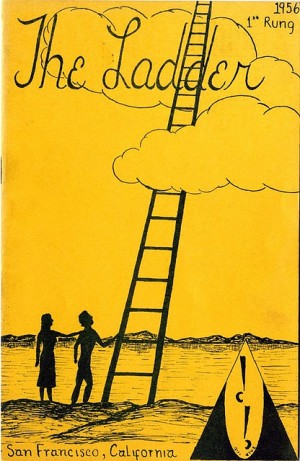
Twice Militant: Lorraine Hansberry
Victoria Brownworth of Lambda Literary places “Twice Militant: Lorraine Hansberry’s Letters to The Ladder” in context. In an essay for Lambda Literary, Victoria Brownworth places “Twice Militant: Lorraine Hansberry’s Letters to The Ladder in context. The small exhibition includes the letters Hansberry wrote in 1957 to The Ladder, the first subscription-based lesbian publication in the United States, published monthly from published monthly from 1956-1970 by a lesbian civil rights group called the Daughters of Bilitis in San Francisco. She notes that the name of the magazine came from the artwork on the debut cover—line drawings showing women moving toward a ladder that disappeared into the clouds and that the magazine sought to connect ordinary lesbians with other lesbians. Indeed, Hansberry’s first letter to the editor states, “I’m glad as heck that you exist.”
Brownworth continues on to give a biographical overview of Hansberry’s life, weaving in reflections on the various pieces of the exhibit, which includes Hansberry’s handwritten lists to herself on her birthdays, an unpublished typewritten essay on “the homosexual question,” a poem titled “Le Masque,” a notebook with a self-portrait sketch, and a listening station with Hansberry’s 1959 conversation with Studs Terkel, where Hansberry states, “Obviously, the most oppressed group of any oppressed group will be its women, who are twice oppressed. So I imagine that they react accordingly: As oppression makes people more militant, women become twice militant, because they are twice oppressed.”
“Twice Militant: Lorraine Hansberry’s Letters to The Ladder” was exhibited in the Herstory Gallery of the Elizabeth A. Sackler Center for Feminist Art from November 22, 2013 through March 16, 2014. The Herstory Gallery is devoted to subjects that explore the significant contributions of the women named in The Dinner Party by Judy Chicago. The exhibit was organized by Catherine Morris, Sackler Family Curator for the Elizabeth A. Sackler Center for Feminist Art, Brooklyn Museum.
The 1956 first issue of The Ladder. From the collection of the GLBT Historical Society.